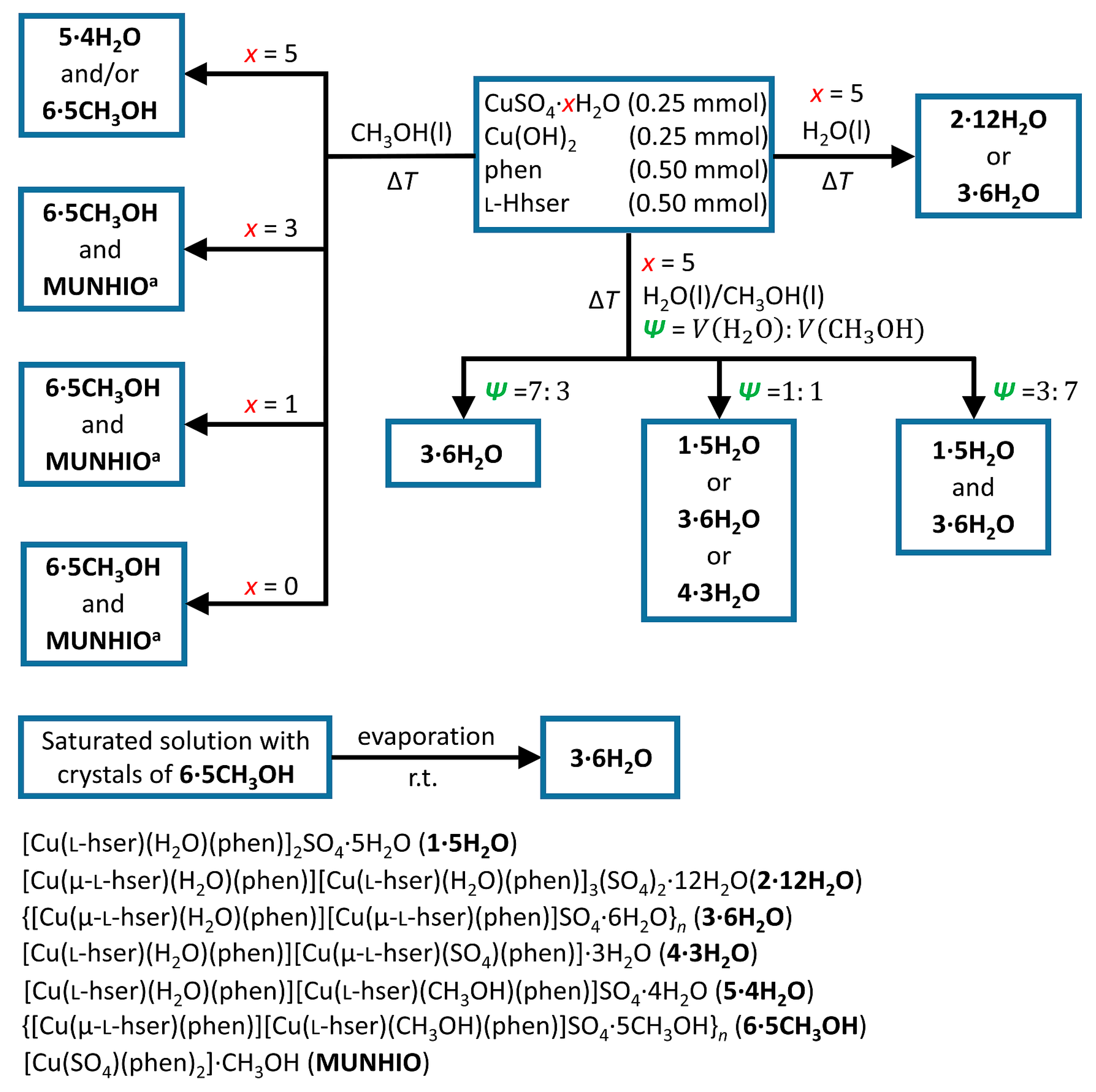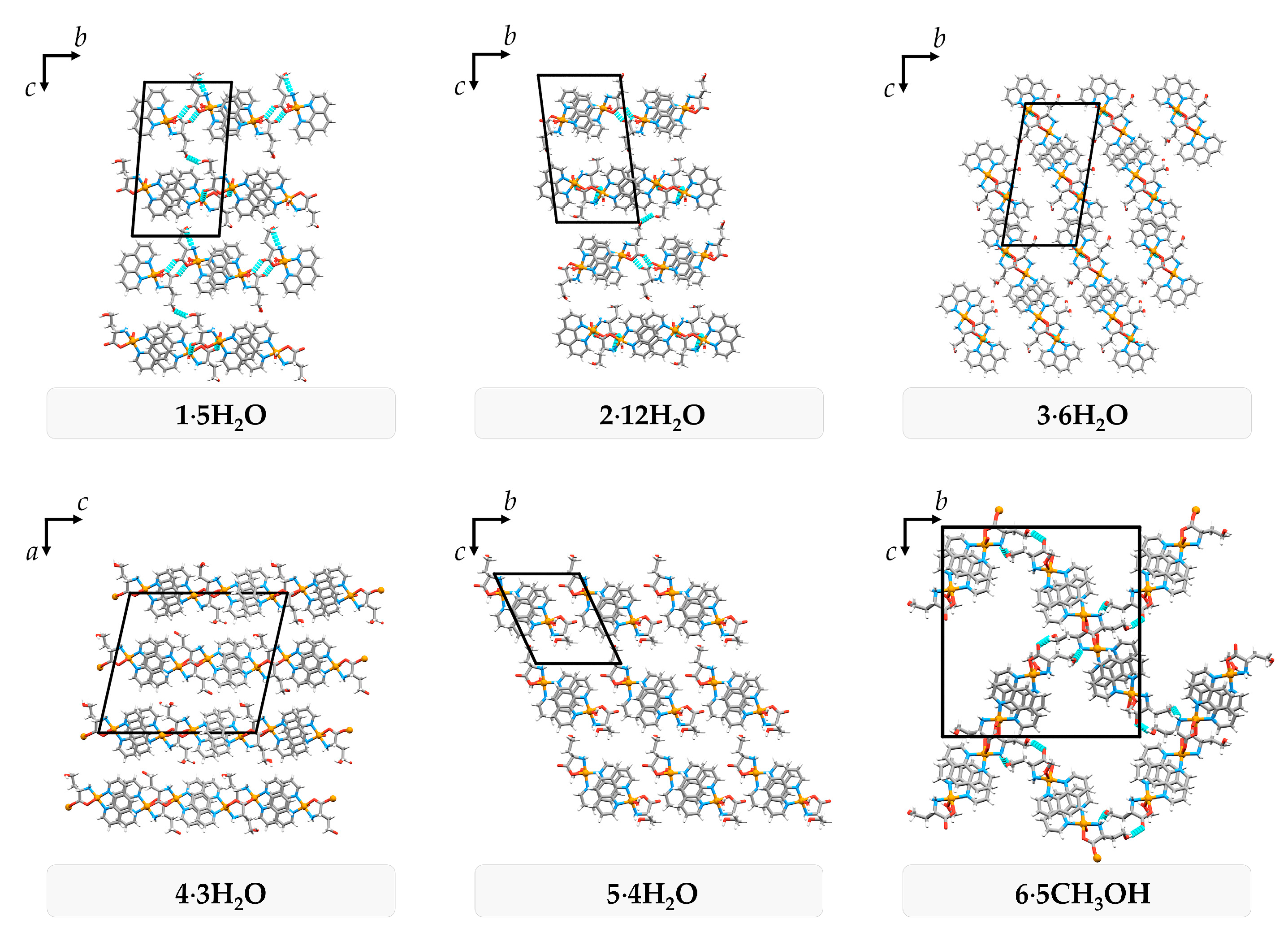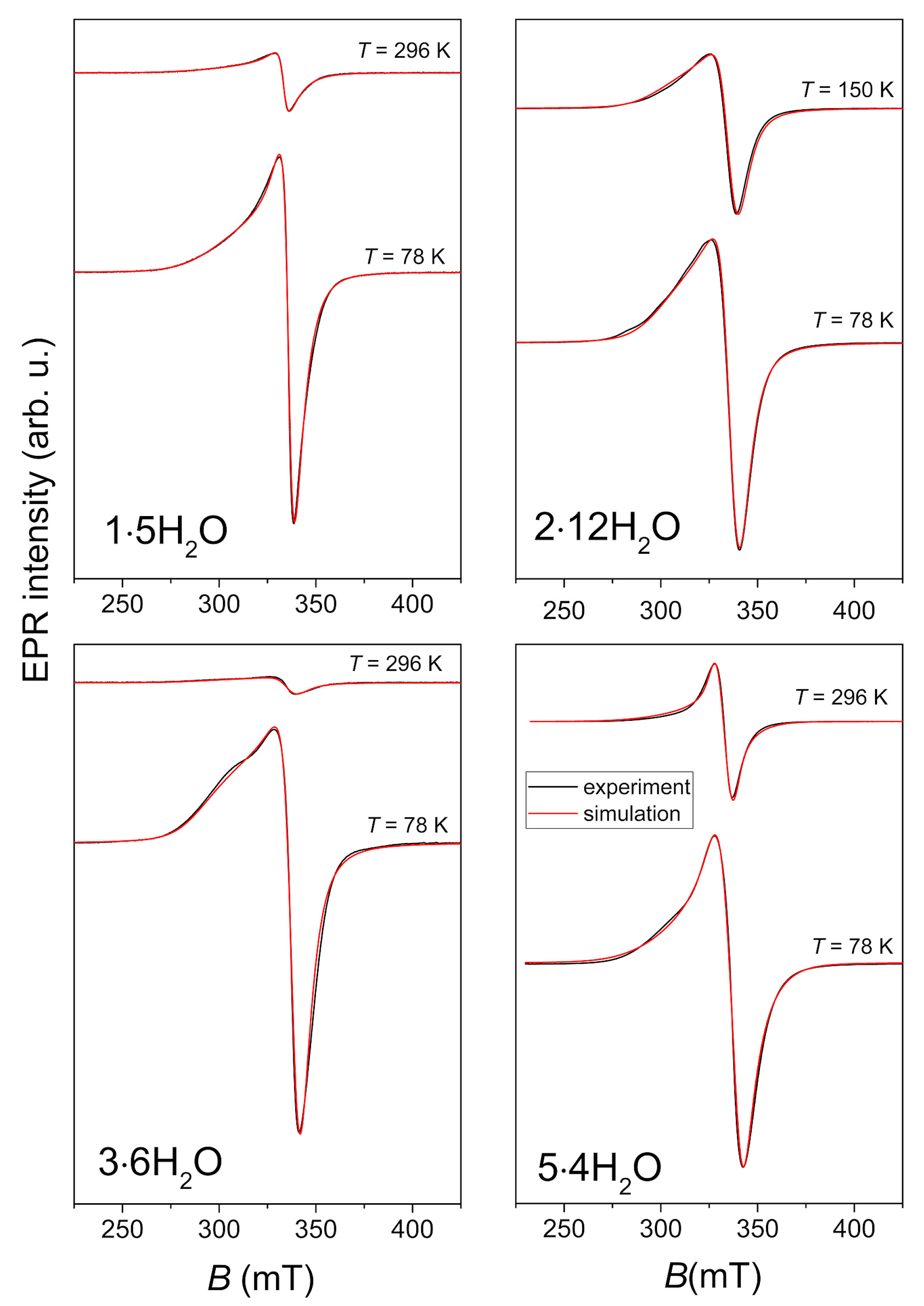Solvatomorphic Diversity in Coordination Compounds of Copper(II) with l-Homoserine and 1,10-Phenanthroline: Syntheses, Crystal Structures and ESR Study
Abstract
1. Introduction
2. Results
2.1. Synthesis and Crystallization
2.2. Crystal Structures
2.3. ESR Spectroscopy
2.4. The Antiproliferative Activities
3. Materials and Methods
3.1. Single-Crystal X-ray Diffraction (SCXRD)
3.1.1. Data Collection and Struture Refinement
3.1.2. Crystal Structure Data
3.2. Synthetic Procedures
3.2.1. General Procedure for Preparation of Compounds
3.2.2. Recrystallization 6∙5CH3OH → 3∙6H2O
3.3. Biological Assays
4. Conclusions
Supplementary Materials
Author Contributions
Funding
Institutional Review Board Statement
Informed Consent Statement
Data Availability Statement
Acknowledgments
Conflicts of Interest
References
- Fujisawa, C.; Kodama, H.; Sato, Y.; Mimaki, M.; Yagi, M.; Awano, H.; Matsuo, M.; Shintaku, H.; Yoshida, S.; Takayanagi, M.; et al. Early clinical signs and treatment of Menkes disease. Mol. Genet. Metab. Rep. 2022, 31, 100849. [Google Scholar] [CrossRef] [PubMed]
- Siotto, M.; Squitti, R. Copper imbalance in Alzheimer’s disease: Overview of the exchangeable copper component in plasma and the intriguing role albumin plays. Coord. Chem. Rev. 2018, 371, 86–95. [Google Scholar] [CrossRef]
- Purchase, R. The Link between Copper and Wilson’s Disease. Sci. Prog. 2013, 96, 213–223. [Google Scholar] [CrossRef] [PubMed]
- Kim, G.; Han, J.; Kim, D.; Jung, O.-S. Construction and catalytic effects of solvent- and metal(ii)-dependent products: The process of transformation of 0D structures into 3D structures. CrystEngComm 2024, 26, 918–925. [Google Scholar] [CrossRef]
- Lim, H.; Oh, C.; Park, M.-S.; Park, H.-B.; Ahn, C.; Bae, W.K.; Yoo, K.H.; Hong, S. Hint from an Enzymatic Reaction: Superoxide Dismutase Models Efficiently Suppress Colorectal Cancer Cell Proliferation. J. Am. Chem. Soc. 2023, 145, 16058–16068. [Google Scholar] [CrossRef] [PubMed]
- Yang, Y.; Tu, C.; Shi, J.; Yang, X.; Liu, J.-J.; Cheng, F. New Stable Cu–K Metal–Organic Framework Constructed by a Bifunctional Ligand: Structure, Application in Dye Adsorption, and Catalytic CO2 Cycloaddition Reaction. Cryst. Growth Des. 2022, 22, 4813–4820. [Google Scholar] [CrossRef]
- Groom, C.R.; Bruno, I.J.; Lightfoot, M.P.; Ward, S.C. The Cambridge Structural Database. Acta Crystallogr. Sect. B Struct. Sci. Cryst. Eng. Mater. 2016, 72, 171–179. [Google Scholar] [CrossRef] [PubMed]
- Yodoshi, M.; Odoko, M.; Okabe, N. Structures and DNA-Binding and Cleavage Properties of Ternary Copper(II) Complexes of Glycine with Phenanthroline, Bipyridine, and Bipyridylamine. Chem. Pharm. Bull. 2007, 55, 853–860. [Google Scholar] [CrossRef]
- Ruiz-Azuara, L.; Bravo-Gomez, M.E. Copper Compounds in Cancer Chemotherapy. Curr. Med. Chem. 2010, 17, 3606–3615. [Google Scholar] [CrossRef]
- Vušak, D.; Ležaić, K.; Jurec, J.; Žilić, D.; Prugovečki, B. Solvent effects on the crystallization and structure of ternary copper(ii) coordination compounds with l-threonine and 1,10-phenanthroline. Heliyon 2022, 8, e09556. [Google Scholar] [CrossRef] [PubMed]
- Vušak, D.; Prugovečki, B.; Milić, D.; Marković, M.; Petković, I.; Kralj, M.; Matković-Čalogović, D. Synthesis and Crystal Structure of Solvated Complexes of Copper(II) with Serine and Phenanthroline and Their Solid-State-to-Solid-State Transformation into One Stable Solvate. Cryst. Growth Des. 2017, 17, 6049–6061. [Google Scholar] [CrossRef]
- Vušak, D.; Špoljarić, K.M.; Jurec, J.; Žilić, D.; Prugovečki, B. Ternary Coordination Compounds of Copper(II) with Glycine and 2,2′-bipyridine: Synthesis, Structural Characterization, Magnetic and Biological Properties. Croat. Chem. Acta 2023, 95, 157–165. [Google Scholar] [CrossRef]
- Zhang, S.; Zhu, Y.; Tu, C.; Wei, H.; Yang, Z.; Lin, L.; Ding, J.; Zhang, J.; Guo, Z. A novel cytotoxic ternary copper(II) complex of 1,10-phenanthroline and l-threonine with DNA nuclease activity. J. Inorg. Biochem. 2004, 98, 2099–2106. [Google Scholar] [CrossRef] [PubMed]
- Seng, H.-L.; Wang, W.-S.; Kong, S.-M.; Ong, H.-K.A.; Win, Y.-F.; Rahman, R.N.Z.R.A.; Chikira, M.; Leong, W.-K.; Ahmad, M.; Khoo, A.S.-B.; et al. Biological and cytoselective anticancer properties of copper(II)-polypyridyl complexes modulated by auxiliary methylated glycine ligand. BioMetals 2012, 25, 1061–1081. [Google Scholar] [CrossRef] [PubMed]
- Rani, J.J.; Roy, S. Recent Development of Copper(II) Complexes of Polypyridyl Ligands in Chemotherapy and Photodynamic Therapy. ChemMedChem 2023, 18, e202200652. [Google Scholar] [CrossRef]
- Figueroa-DePaz, Y.; Pérez-Villanueva, J.; Soria-Arteche, O.; Martínez-Otero, D.; Gómez-Vidales, V.; Ortiz-Frade, L.; Ruiz-Azuara, L. Casiopeinas of Third Generations: Synthesis, Characterization, Cytotoxic Activity and Structure–Activity Relationships of Mixed Chelate Compounds with Bioactive Secondary Ligands. Molecules 2022, 27, 3504. [Google Scholar] [CrossRef]
- Golubeva, Y.A.; Lider, E.V. Copper(ii) Complexes Based on 2,2′-Bipyridine and 1,10-Phenanthroline as Potential Objects for Developing Antitumor Drugs. J. Struct. Chem. 2024, 65, 1159–1209. [Google Scholar] [CrossRef]
- Ji, P.; Wang, P.; Chen, H.; Xu, Y.; Ge, J.; Tian, Z.; Yan, Z. Potential of Copper and Copper Compounds for Anticancer Applications. Pharmaceuticals 2023, 16, 234. [Google Scholar] [CrossRef]
- Li, X.; Zhang, Z.; Wang, C.; Zhang, T.; He, K.; Deng, F. Synthesis, crystal structure and action on Escherichia coli by microcalorimetry of copper complexes with 1,10-phenanthroline and amino acid. J. Inorg. Biochem. 2011, 105, 23–30. [Google Scholar] [CrossRef]
- Galindo-Murillo, R.; Garcia-Ramos, J.C.; Ruiz-Azuara, L.; Cheatham, T.E.; Cortes-Guzman, F. Intercalation processes of copper complexes in DNA. Nucleic Acids Res. 2015, 43, 5364–5376. [Google Scholar] [CrossRef]
- Teodoru, D.V.; Olar, R.; Maxim, C.; Bacalum, M.; Răileanu, M.; Iorgulescu, E.-E.; Vasile Scăețeanu, G.; Badea, M. Copper(II) Methacrylate Complexes with Imidazole Derivatives—Structural, Spectral and Antitumor Features. Molecules 2024, 29, 4010. [Google Scholar] [CrossRef] [PubMed]
- Wang, W.; Su, K.; El-Sayed, E.-S.M.; Yang, M.; Yuan, D. Solvatomorphism Influence of Porous Organic Cage on C2H2/CO2 Separation. ACS Appl. Mater. Interfaces 2021, 13, 24042–24050. [Google Scholar] [CrossRef] [PubMed]
- Shanthakumar, K.C.; Sridhara, P.G.; Rajabathar, J.R.; Al-Lohedan, H.A.; Lokanath, N.K.; Krishnegowda, H.M. Unveiling a Novel Solvatomorphism of Anti-inflammatory Flufenamic Acid: X-ray Structure, Quantum Chemical, and In Silico Studies. ACS Omega 2024, 9, 20753–20772. [Google Scholar] [CrossRef] [PubMed]
- Grell, T.; Barbero, M.; Pattarino, F.; Giovenzana, G.B.; Colombo, V. Solvatomorphism of Moxidectin. Molecules 2021, 26, 4869. [Google Scholar] [CrossRef] [PubMed]
- Ren, C.-X.; Ji, M.; Yao, Q.-X.; Cai, L.-X.; Tan, B.; Zhang, J. Targeted Functionalization of Porous Materials for Separation of Alcohol/Water Mixtures by Modular Assembly. Chem. A Eur. J. 2014, 20, 14846–14852. [Google Scholar] [CrossRef] [PubMed]
- Lou, B.-Y.; Jiang, F.-L.; Wu, B.-L.; Yuan, D.-Q.; Hong, M.-C. From Helical Array to Porous Architecture: Exploring the Use of Side Chains of Amino Acids to Engineer 1D Infinite Coordination Polymeric Chain into Porous Frameworks. Cryst. Growth Des. 2006, 6, 989–993. [Google Scholar] [CrossRef]
- Baggio, R.F.; Calvo, R.; Brondino, C.; Garland, M.T.; Atria, A.M.; Spodine, E. A Novel Structure of (L-Aspartato)(1,10-phenanthroline)copper(II) Hydrate. Acta Crystallogr. Sect. C Cryst. Struct. Commun. 1995, 51, 382–385. [Google Scholar] [CrossRef]
- Mu, Q.; Zhang, S.; Mao, X.; Tao, Y.; Yu, B. Highly efficient production of L-homoserine in Escherichia coli by engineering a redox balance route. Metab. Eng. 2021, 67, 321–329. [Google Scholar] [CrossRef]
- Chacko, K.K.; Swaminathan, S.; Veena, K.R. L-HOMOSERINE, C4H9NO3. Cryst. Struct. Commun. 1982, 11, 2057. [Google Scholar]
- Dittrich, B.; Sze, E.; Holstein, J.J.; Hübschle, C.B.; Jayatilaka, D. Crystal-field effects in L-homoserine: Multipoles versus quantum chemistry. Acta Crystallogr. Sect. A Found. Crystallogr. 2012, 68, 435–442. [Google Scholar] [CrossRef]
- Woińska, M.; Grabowsky, S.; Dominiak, P.M.; Woźniak, K.; Jayatilaka, D. Hydrogen atoms can be located accurately and precisely by x-ray crystallography. Sci. Adv. 2016, 2, e1600192. [Google Scholar] [CrossRef] [PubMed]
- Biancalana, L.; Abdalghani, I.; Chiellini, F.; Zacchini, S.; Pampaloni, G.; Crucianelli, M.; Marchetti, F. Ruthenium Arene Complexes with α-Aminoacidato Ligands: New Insights into Transfer Hydrogenation Reactions and Cytotoxic Behaviour. Eur. J. Inorg. Chem. 2018, 2018, 3041–3057. [Google Scholar] [CrossRef]
- Melnic, E.; Coropceanu, E.B.; Kulikova, O.V.; Siminel, A.V.; Anderson, D.; Rivera-Jacquez, H.J.; Masunov, A.E.; Fonari, M.S.; Kravtsov, V.C. Robust Packing Patterns and Luminescence Quenching in Mononuclear [Cu(II)(phen)2] Sulfates. J. Phys. Chem. C 2014, 118, 30087–30100. [Google Scholar] [CrossRef]
- Stoll, S.; Schweiger, A. EasySpin, a comprehensive software package for spectral simulation and analysis in EPR. J. Magn. Reson. 2006, 178, 42–55. [Google Scholar] [CrossRef] [PubMed]
- Carrington, A.; McLachlan, A.D. Introduction to Magnetic Resonance; Harper & Row: New York, NY, USA, 1967. [Google Scholar]
- Kahn, O. Molecular Magnetism; Wiley-VCH Verlag GmbH & Co. KGaA: New York, NY, USA, 1993. [Google Scholar]
- Garribba, E.; Micera, G. The Determination of the Geometry of Cu(II) Complexes: An EPR Spectroscopy Experiment. J. Chem. Educ. 2006, 83, 1229. [Google Scholar] [CrossRef]
- Perin, N.; Nhili, R.; Cindrić, M.; Bertoša, B.; Vušak, D.; Martin-Kleiner, I.; Laine, W.; Karminski-Zamola, G.; Kralj, M.; David-Cordonnier, M.-H.; et al. Amino substituted benzimidazo[1,2-a]quinolines: Antiproliferative potency, 3D QSAR study and DNA binding properties. Eur. J. Med. Chem. 2016, 122, 530–545. [Google Scholar] [CrossRef]
- Pršir, K.; Horak, E.; Kralj, M.; Uzelac, L.; Liekens, S.; Steinberg, I.M.; Krištafor, S. Design, Synthesis, Spectroscopic Characterisation and In Vitro Cytostatic Evaluation of Novel Bis(coumarin-1,2,3-triazolyl)benzenes and Hybrid Coumarin-1,2,3-triazolyl-aryl Derivatives. Molecules 2022, 27, 637. [Google Scholar] [CrossRef]
- Bravo-Gómez, M.E.; Campero-Peredo, C.; García-Conde, D.; Mosqueira-Santillán, M.J.; Serment-Guerrero, J.; Ruiz-Azuara, L. DNA-binding mode of antitumoral copper compounds (Casiopeinas®) and analysis of its biological meaning. Polyhedron 2015, 102, 530–538. [Google Scholar] [CrossRef]
- Santini, C.; Pellei, M.; Gandin, V.; Porchia, M.; Tisato, F.; Marzano, C. Advances in Copper Complexes as Anticancer Agents. Chem. Rev. 2014, 114, 815–862. [Google Scholar] [CrossRef]
- Degen, T.; Sadki, M.; Bron, E.; König, U.; Nénert, G. The HighScore suite. Powder Diffr. 2014, 29, S13–S18. [Google Scholar] [CrossRef]
- DataViewer, version 1.9a; PANalytical, B.V.: Almelo, The Nederlands, 2018.
- CrysAlisPRO, version 171.42.63a; Rigaku Oxford Diffraction: Yarnton, UK, 2022.
- Sheldrick, G.M. A short history of SHELX. Acta Crystallogr. Sect. A Found. Crystallogr. 2008, 64, 112–122. [Google Scholar] [CrossRef] [PubMed]
- Sheldrick, G.M. Crystal structure refinement with SHELXL. Acta Crystallogr. Sect. C Struct. Chem. 2015, 71, 3–8. [Google Scholar] [CrossRef] [PubMed]
- Farrugia, L.J. WinGX and ORTEP for Windows: An update. J. Appl. Crystallogr. 2012, 45, 849–854. [Google Scholar] [CrossRef]
- Macrae, C.F.; Sovago, I.; Cottrell, S.J.; Galek, P.T.A.; McCabe, P.; Pidcock, E.; Platings, M.; Shields, G.P.; Stevens, J.S.; Towler, M.; et al. Mercury 4.0: From visualization to analysis, design and prediction. J. Appl. Crystallogr. 2020, 53, 226–235. [Google Scholar] [CrossRef] [PubMed]
- Spek, A.L. Single-crystal structure validation with the program PLATON. J. Appl. Crystallogr. 2003, 36, 7–13. [Google Scholar] [CrossRef]






| Compound | Types of Complex Species |
|---|---|
| 1∙5H2O | Type 1 |
| 2∙12H2O | Type 1 and 2 |
| 3∙6H2O | Type 2 and 3 |
| 4∙3H2O | Type 3 |
| 5∙4H2O | Type 1 |
| 6∙5CH3OH | Type 1 and 3 |
| Complex | g = [gx gy gz] | gstrain | A (MHz) | lw (mT) | T (K) |
|---|---|---|---|---|---|
| 1·5H2O | [2.06 2.06 2.23] | [0.0 0.0 0.35] [0.0 0.26 0.28] | [0 0 146] | 3.9 4.7 | 296 78 |
| 2·12H2O | [2.05 2.08 2.22] | [0.0 0.0 0.15] [0.0 0.0 0.15] | [0 0 246] | 7.5 7.5 | 150 78 |
| 3·6H2O | [2.05 2.06 2.27] | [0.0 0.0 0.15] [0.0 0.0 0.20] | [0 0 270] | 9.5 8 | 296 78 |
| 5·4H2O | [2.04 2.08 2.18] | [0.04 0.04 0.38] [0.03 0.05 0.36] | [0 0 136] | 0.2 3.8 | 296 78 |
| Compound | IC50a/10−6 mol dm−3 | ||
|---|---|---|---|
| Cell Lines | |||
| HCT116 | MCF-7 | H 460 | |
| 3·6H2O | 1.5 ± 0.3 | 1.7 ± 0.02 | 2.13 ± 0.17 |
| [Cu(l-ser)(H2O)(phen)]2SO4∙6H2O | - b | 2 ± 0.08 c | 2 ± 0.2 c |
| etoposide | 5 ± 2 d, e | 1 ± 0.7 d, e | 0.1 ± 0.04 d, e |
| 5-fluorouracil | 4 ± 1 e | 14 ± 0.3 e | 3 ± 0.3 e |
Disclaimer/Publisher’s Note: The statements, opinions and data contained in all publications are solely those of the individual author(s) and contributor(s) and not of MDPI and/or the editor(s). MDPI and/or the editor(s) disclaim responsibility for any injury to people or property resulting from any ideas, methods, instructions or products referred to in the content. |
© 2024 by the authors. Licensee MDPI, Basel, Switzerland. This article is an open access article distributed under the terms and conditions of the Creative Commons Attribution (CC BY) license (https://creativecommons.org/licenses/by/4.0/).
Share and Cite
Vušak, D.; Šimunović Letić, M.; Tašner, M.; Matković-Čalogović, D.; Jurec, J.; Žilić, D.; Prugovečki, B. Solvatomorphic Diversity in Coordination Compounds of Copper(II) with l-Homoserine and 1,10-Phenanthroline: Syntheses, Crystal Structures and ESR Study. Molecules 2024, 29, 5621. https://doi.org/10.3390/molecules29235621
Vušak D, Šimunović Letić M, Tašner M, Matković-Čalogović D, Jurec J, Žilić D, Prugovečki B. Solvatomorphic Diversity in Coordination Compounds of Copper(II) with l-Homoserine and 1,10-Phenanthroline: Syntheses, Crystal Structures and ESR Study. Molecules. 2024; 29(23):5621. https://doi.org/10.3390/molecules29235621
Chicago/Turabian StyleVušak, Darko, Marta Šimunović Letić, Marina Tašner, Dubravka Matković-Čalogović, Jurica Jurec, Dijana Žilić, and Biserka Prugovečki. 2024. "Solvatomorphic Diversity in Coordination Compounds of Copper(II) with l-Homoserine and 1,10-Phenanthroline: Syntheses, Crystal Structures and ESR Study" Molecules 29, no. 23: 5621. https://doi.org/10.3390/molecules29235621
APA StyleVušak, D., Šimunović Letić, M., Tašner, M., Matković-Čalogović, D., Jurec, J., Žilić, D., & Prugovečki, B. (2024). Solvatomorphic Diversity in Coordination Compounds of Copper(II) with l-Homoserine and 1,10-Phenanthroline: Syntheses, Crystal Structures and ESR Study. Molecules, 29(23), 5621. https://doi.org/10.3390/molecules29235621







